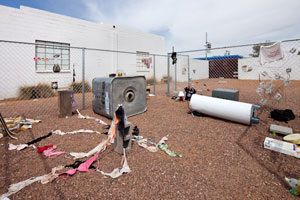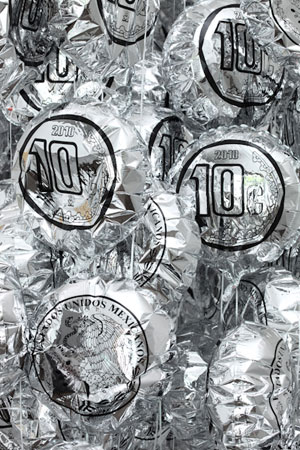When curator Alicia Ritson first watched Carta Abierta a Dr. Atl (An Open Letter to Dr. Atl) at the 2007 Venice Biennale, she knew right away she wanted to show the video in Marfa. Now on display in the group exhibition In Lieu of Unity, Mario Garcia Torres’ video layers six minutes of Super 8 footage of the Barranca de Oblatos canyon in Guadalajara, Mexico with the text of his letter to Dr. Atl, a much admired Mexican artist renowned for capturing breathtaking vistas on canvas.
“You know, now more than ever, art is closely related to tourism,” Torres writes in his letter.
Ritson curates exhibitions for Ballroom Marfa, a nonprofit space located in a small West Texas town that attracts 10,000 visitors a year to see large-scale installations by the canonical Minimalist artist Donald Judd. For In Lieu of Unity, Ritson chose to move away from the Minimalist aesthetic associated with Marfa and instead focus on the town’s proximity to Mexico, about an hour’s drive south. The exhibition features work by ten artists and one artist collective, all of whom are current or former residents of Mexico.
Despite the curator’s conscious shift away from the look of Minimalism, this exhibition clings tightly to other aspects of Judd’s legacy. As illustrated by Torres’ video of scenic canyon panoramas, many participating artists share Judd’s attraction to landscape, a key factor in the artist’s decision to establish a residence in Marfa in the 1970s. Teresa Margolles’ video features views along the drive from Marfa to nearby Alpine, Minerva Cuevas’ contribution includes large-scale photographs of the Rio Grande by Erika Blumenfeld and Margarita Cabrera creates her own landscape with sculptures designed to resemble desert plants.
With only two wall labels in the entire gallery space, In Lieu of Unity also holds the line on Judd’s rejection of didacticism and interpretation. This is unfortunate—there’s much more to the art on display than meets the eye, and short of having a conversation with a member of the gallery staff, the average visitor will leave the space without understanding the layers of language, politics, commerce and culture surrounding the work. Participating artists explore issues of identity in ways that call attention to our lack of common experience—a divide that, by design or not, is highlighted by the unavailability of wall text and background information on the work. The exhibition’s title, inspired by the writings of French theorist Jean-Luc Nancy, means to affirm those differences and reject the utopian notions of unity typically associated with community.

Eduardo Abaroa, (detail), Eighty Prepositions in...English and their Spanish equivalents, 2010...Assorted mediums and objects, Dimensions variable...Commissioned by Ballroom Marfa...Photography © Fredrik Nilsen
Eduardo Abaroa’s Eighty Prepositions in English and their Spanish equivalents, an installation in the Ballroom Marfa courtyard, focuses on language gaps. For this work, Abaroa attaches white plastic letters spelling prepositions in both English and Spanish—under/bajo, against/contra, for/por/para—to a chain-link fence. Inside the enclosure, Abaroa has placed junk store finds collected in Marfa and surrounding towns as well as Ojinaga and Juarez, Mexico. These items—old T-shirts and bras, paperback books, broken furniture, all left to deteriorate in the extreme West Texas sunlight and wind—serve as nonsensical illustrations of the words attached to the fence. By choosing prepositions, words that express relationships, and allowing his installation to decompose in the harsh climate, Abaroa sends a strong message about communication breakdowns and their effect on connections among people.
Minerva Cuevas also plays with language in her work. In SU-US-US, an action captured in a photograph by Erika Blumenfeld, Cuevas paints the letters SU in limestone on rocks lining the bank of the Rio Grande, the river forming the natural border between the United States and Mexico. Here, the “S” and “U” could stand for many different things: Estados Unidos Mexicanos, United States of America, su (which translates to “your” in English), or us. By writing two letters with such a mutable meaning on the border between the United States and Mexico, Cuevas calls attention to the fact that this boundary, and the responsibilities for the complications surrounding it, are shared by the residents and policymakers of both countries.

Teresa Margolles, Irrigación, 2010...Documentation of action: video and newspapers...collected from Ciudad Juarez...Commissioned by Ballroom Marfa...Photography © Fredrik Nilsen
Although this exhibition opened before Arizona Governor Jan Brewer signed SB 1070 into law, it’s hard not to think of the controversial immigration ordinance when viewing Teresa Margolles’ Irrigación. Projected on the gallery wall, Margolles’ video shows footage of a truck driving Highway 90 through Marfa east toward Alpine, drenching the road with water. One of the two wall labels in the exhibition, a statement by the artist, provides background information in both Spanish and English on the act documented by the video. Margolles immersed dampened cloths that had been placed on sites of violent acts in Juarez into the 5,000 gallons of water filling the tank on the back of the truck. Margolles closes her explanation of the work with a straightforward and arresting fact: From January through March of 2010, more than 500 people were murdered in Juarez. This piece of information is underscored by a collection of Spanish language newspapers displayed on a table underneath the artist’s statement. Fluent reading knowledge of Spanish is not necessary to grasp the magnitude of the violent acts detailed in the newspapers—each cover features photos of uniformed members of law enforcement or bloody bodies.
Margolles’ work has a sense of desperate futility: Why irrigate a surface where nothing can grow? Yet at the same time, by depicting the remains of violent acts 250 miles away from where they took place, the work disseminates responsibility and awareness. What Margolles finally offers is a cleansing feeling—the sound of the rushing water fills the gallery as the truck moves along the highway.
Thanks in part to the brief artist statement (in addition to the graphic newspaper photographs), Irrigación is the most confrontational and hard-hitting work in the exhibition. Pedro Reyes’ Palas por pistolas, which shares the south gallery with Irrigación, also consists of an action designed to increase awareness of violence, but without an explanation the work’s effect isn’t as strong. Reyes collected weapons by offering to trade for food stamps, then melted the weapons down to create shovels. Each of the 1,527 shovels will be used to plant a tree. On display in the gallery is a wilted, potted tree next to a shovel on a pedestal.

Maximo Gonzalez, Inflation, 2004/2010...Installation of 1000 mylar balloons 18 inch diameter,...blown up with helium gas...Courtesy of the artist, Photography © Fredrik Nilsen
In Lieu of Unity’s underlying theme of community is strengthened by the fact that, like Palas por pistolas, many works in the exhibition would not have been possible without the help of collaborators. In Paulina Lasa’s untitled work, visitors wear rings collected in Marfa and neighboring Alpine and Ft. Davis, attached to colorful strands of yarn tethered to the gallery wall. The yarn tangles and knots together as visitors move among one another. Maximo Gonzalez’s Inflation consists of 1,000 helium balloons featuring the design of 10 centavos coins. During the opening, balloons were distributed to gallery visitors; since then, the balloons have begun to deflate, reflecting the state of Mexican currency.
For Margarita Cabrera’s Space In Between, a series of fiber sculptures resembling desert plants, Cabrera teamed up with nine recent immigrants from Central and South America working at Box 13 in Houston. The artist taught each woman a form of indigenous Mexican embroidery, which they used to illustrate their own immigration stories by stitching onto olive-green fabric once used for border patrol uniforms. Decorated with ominous imagery such as helicopters, tall fences and snakes, as well as happy scenes of smiling families rendered in thick stitches of brightly colored thread, the sculptures elicit both dread and contentment.
Cabrera’s collaborators are listed by name in the exhibition checklist, but unfortunately Ballroom Marfa neglects to inform viewers that these women are telling their own immigration stories. Still, the lack of explanation allows Space In Between to subtly reinforce the point Ritson makes with In Lieu of Unity: community is not based purely on shared experience.
![]()
Theresa Bembnister is a writer currently based in Marfa, Texas.




